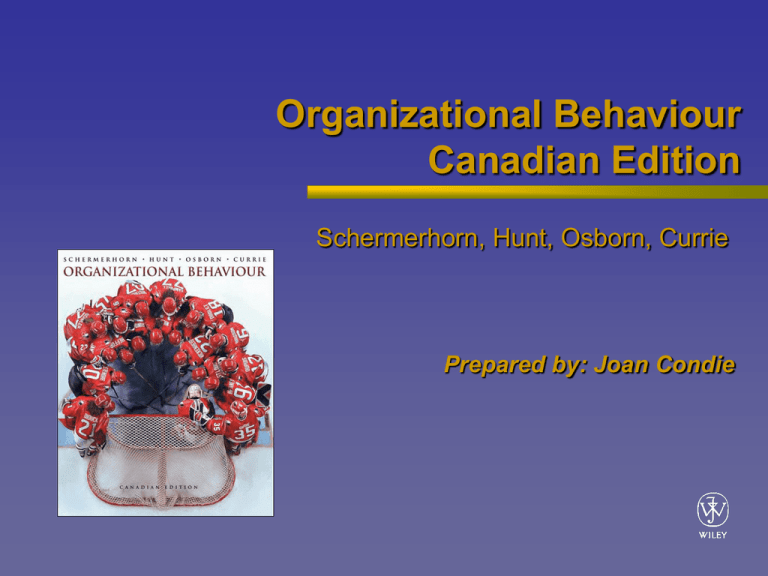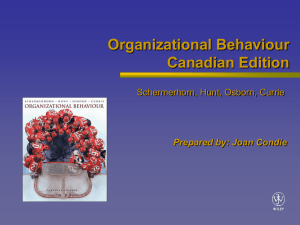
Organizational Behaviour
Canadian Edition
Schermerhorn, Hunt, Osborn, Currie
Prepared by: Joan Condie
Chapter 13
Organizational Cultures
Questions
What is organizational culture?
What aspects of organizational culture can be
observed?
How do values and assumptions influence
organizational culture?
How can the organizational culture be managed,
nurtured, and guided?
How can the process of organizational
development improve organizational culture?
Schermerhorn, Hunt, Osborn, Currie Organizational Behaviour, Canadian Edition Copyright 2005 John Wiley & Sons Canada, Ltd.
Organizational Culture
(or Corporate Culture)
Organizational culture is the system of shared
actions, values, and beliefs that develops within an
organization and guides the behaviour of its
members
Has a major impact on organizational performance
and on quality of work life experienced by
members
Schermerhorn, Hunt, Osborn, Currie Organizational Behaviour, Canadian Edition Copyright 2005 John Wiley & Sons Canada, Ltd.
Culture Iceberg
Visible
Artifacts
---------------------------------Expressed
Espoused Values
Unconscious
Basic Underlying Assumptions
Schermerhorn, Hunt, Osborn, Currie Organizational Behaviour, Canadian Edition Copyright 2005 John Wiley & Sons Canada, Ltd.
Functions of Organizational Culture
External Adaptation – reaching goals and dealing with
outsiders; concerns include the tasks to be accomplished,
methods to achieve goals and to cope with success and failure
Done by developing answers to the following:
•
•
•
•
•
•
•
•
•
What is our real mission?
How do we contribute?
What are our goals?
How do we reach our goals?
What external forces are important?
How do we measure results?
What do we do if specific targets aren’t met?
How do we tell others how good we are?
When do we quit?
Schermerhorn, Hunt, Osborn, Currie Organizational Behaviour, Canadian Edition Copyright 2005 John Wiley & Sons Canada, Ltd.
Functions of Organizational
Culture
Internal Integration – the creation of a collective
identity and finding ways of working together
Done by developing answers to the following:
•
•
•
•
•
•
What is our unique identity?
How do we view the world?
Who is a member?
How do we allocate power, status, authority?
How do we communicate?
What is the basis for friendship?
Schermerhorn, Hunt, Osborn, Currie Organizational Behaviour, Canadian Edition Copyright 2005 John Wiley & Sons Canada, Ltd.
Dominant Culture, Subcultures,
Countercultures
Dominant culture = unifying set of shared actions,
values and beliefs across entire organization
Subculture = unique patterns of values and
philosophies within a group that fit with the dominant
culture of the larger organization
•
•
Often found in high-performance teams
May reflect subgroup in larger society (if so, danger
of becoming a counterculture)
Countercultures = patterns of values and philosophies
that reject those of the larger organization
Schermerhorn, Hunt, Osborn, Currie Organizational Behaviour, Canadian Edition Copyright 2005 John Wiley & Sons Canada, Ltd.
Multicultural Organization
Cox suggests organizations should value diversity
but block transfer of subcultures from society into the
organization by developing pluralism:
1. Educate so increased information, no stereotyping
2. Integrate structure so no relationship between a
naturally occurring group and any particular job
3. Integrate informal networks
4. Break link between naturally occurring group identity
and identity of firm
5. Work to eliminate conflict between individuals based
on group identity or backlash
Schermerhorn, Hunt, Osborn, Currie Organizational Behaviour, Canadian Edition Copyright 2005 John Wiley & Sons Canada, Ltd.
Levels of Cultural Analysis
Observable culture
Artifacts
Espoused values
Stories, rituals,
ceremonies
Strategies, goals,
philosophies
Espoused Values
Common assumptions
Taken-for-granted truths
shared as result of joint
experience
Basic Underlying Assumptions
Schermerhorn, Hunt, Osborn, Currie Organizational Behaviour, Canadian Edition Copyright 2005 John Wiley & Sons Canada, Ltd.
Observable Culture
Stories
Rituals
E.g., how certain occasions are celebrated
Language
E.g., founding of organization, how boss reacted to
a mistake, why someone fired
E.g., jargon
Cultural symbols
E.g., uniform
Schermerhorn, Hunt, Osborn, Currie Organizational Behaviour, Canadian Edition Copyright 2005 John Wiley & Sons Canada, Ltd.
Values and
Organizational Culture
“Strong” culture has value system broadly and
deeply shared by members
Result:
Strong corporate identity
Increased commitment of employees
Stable social system
Reduced need for formal, bureaucratic controls
BUT also perhaps a one-dimensional view of the
organization and its environment
Schermerhorn, Hunt, Osborn, Currie Organizational Behaviour, Canadian Edition Copyright 2005 John Wiley & Sons Canada, Ltd.
Organizational Myths
Organizational myth = an unproven and often
unstated belief that is accepted uncritically
May not be logical but still have function:
Allow executives to redefine impossible problems
into more manageable components
Can encourage experimentation
Allow managers to govern
Schermerhorn, Hunt, Osborn, Currie Organizational Behaviour, Canadian Edition Copyright 2005 John Wiley & Sons Canada, Ltd.
National Culture
Often basic assumptions in an organization’s
culture derive from the larger society (e.g.,
preference for individualism or collectivism)
Managers moving from dealing with one national
culture to another must be sensitive to different
expectations, generally accepted solutions
Schermerhorn, Hunt, Osborn, Currie Organizational Behaviour, Canadian Edition Copyright 2005 John Wiley & Sons Canada, Ltd.
Managing
Organizational Culture
Culture influences performance as do structure
and strategy
Starts with management philosophy
•
•
•
It establishes generally understood boundaries
It provides a consistent way of approaching new
situations
It helps keep individuals together by assuring
them path to success is known
Schermerhorn, Hunt, Osborn, Currie Organizational Behaviour, Canadian Edition Copyright 2005 John Wiley & Sons Canada, Ltd.
Managing
Organizational Culture (cont’d)
Two approaches:
Directly modifying observable culture, shared
values, common assumptions
Using organizational development techniques to
modify specific elements of the culture
Schermerhorn, Hunt, Osborn, Currie Organizational Behaviour, Canadian Edition Copyright 2005 John Wiley & Sons Canada, Ltd.
Building, Reinforcing and
Changing Culture
Managers modify visible aspects of culture, e.g.,
interpret situations in new ways, create new rituals
Managers set example, e.g., relative attention paid to
customers, shareholders, employees
Direct attempts to change values by resocializing often
fail
Attempts to change values need to be supported by
changes to how the organization works and a
recognition of importance of individuals
Mistake to force major changes and ignore shared
values
Schermerhorn, Hunt, Osborn, Currie Organizational Behaviour, Canadian Edition Copyright 2005 John Wiley & Sons Canada, Ltd.
Organizational Development
(OD)
OD = comprehensive approach to planned change
designed to improve overall effectiveness
OD uses behavioural-science knowledge in long-term
effort to improve an organization’s ability to respond to
change in external environment and increase its
problem-solving capabilities
Wants to create change in a way that results in
organizational members being active in taking similar
steps in future
Schermerhorn, Hunt, Osborn, Currie Organizational Behaviour, Canadian Edition Copyright 2005 John Wiley & Sons Canada, Ltd.
OD Assumptions and Values
OD assumes:
Respect for individuals, their need for growth in
supportive environment, their capacity to take
responsibility
Belief that groups can be good for people and
organizations
Respect for complexity of the organization as a system
of interdependent parts
OD addresses two main goals:
Outcome goals
Process goals
Schermerhorn, Hunt, Osborn, Currie Organizational Behaviour, Canadian Edition Copyright 2005 John Wiley & Sons Canada, Ltd.
Action Research
Foundation of OD
Action research = the process of systematically
collecting data on an organization, feeding it back for
action planning, and evaluating results by collecting
and reflecting on more data
Perception of problem
Data gathering
Data feedback
Data analysis
Action planning
Action taken
Results evaluated
Schermerhorn, Hunt, Osborn, Currie Organizational Behaviour, Canadian Edition Copyright 2005 John Wiley & Sons Canada, Ltd.
OD Interventions
Organization-wide:
Survey feedback
•
Confrontation meeting
•
One-day meeting conducted by OD facilitator to identify
needed improvements
Structural redesign
•
Collection of data from questionnaires answered by
members, results interpreted and action planned
Realign whole organization or major subsystem
Collateral organization
•
Representative members in periodic, small-group,
problem-solving sessions
Schermerhorn, Hunt, Osborn, Currie Organizational Behaviour, Canadian Edition Copyright 2005 John Wiley & Sons Canada, Ltd.
OD Interventions
Group and Intergroup Interventions
Team-building
•
Process consultation
•
Series of activities to collaboratively examine how the
group functions and how it could function better
Structured activities guided by OD consultant to
improve specific aspects, e.g., norms,
communication, cohesiveness
Intergroup team-building
•
To help two or more groups improve their working
relationship
Schermerhorn, Hunt, Osborn, Currie Organizational Behaviour, Canadian Edition Copyright 2005 John Wiley & Sons Canada, Ltd.
OD Interventions
Individual Interventions
Role negotiation
•
Job redesign
•
Process through which individuals clarify their
expectations about what they are to give and receive
from each other in the work relationship
Creates a long-term fit between individual goals and
career opportunities in the organization, e.g., job
enrichment
Career planning
•
Structured opportunities for individuals to work with
their managers on career issues
Schermerhorn, Hunt, Osborn, Currie Organizational Behaviour, Canadian Edition Copyright 2005 John Wiley & Sons Canada, Ltd.
Copyright
Copyright © 2005 John Wiley & Sons Canada, Ltd. All rights reserved.
Reproduction or translation of this work beyond that permitted by
Access Copyright (The Canadian Copyright Licensing Agency) is
unlawful. Requests for further information should be addressed to the
Permissions Department, John Wiley & Sons Canada, Ltd. The
purchaser may make back-up copies for his or her own use only and
not for distribution or resale. The author and the publisher assume no
responsibility for errors, omissions, or damages caused by the use of
these programs or from the use of the information contained herein.




